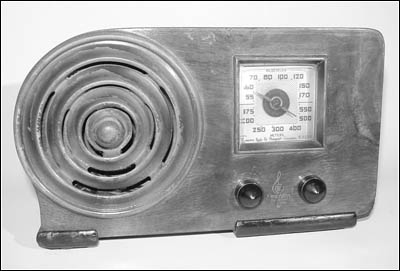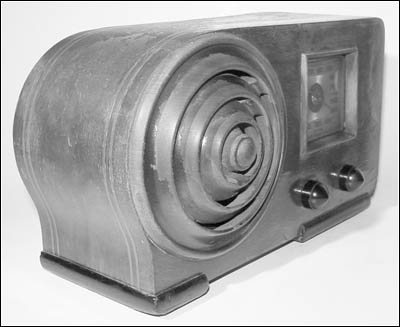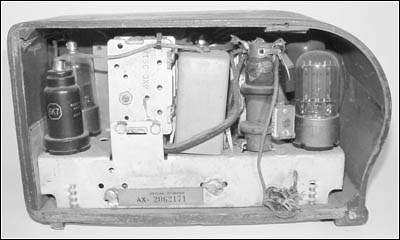Of Old Radios And Related Items--Published Monthly
Emerson Model AX-212
A "Little Miracle" RadioBY RICHARD ARNOLD
WEB EDITION
Once again Richard Arnold describes a particular set that captured his interest. But, he also adds much information about the times leading up to the manufacture of this set and increases our general knowledge of this segment of radio history. (Editor)
The 1938 Emerson Model AX-212, "Little Miracle," shown in Figure 1, is what collectors nowadays call the "Bullseye." This radio is owned by Mr. Paul Turney who has a web site located at paul@tuberadioland.com. He has been kind enough to allow me to use the pictures of his radio that are posted on his site for this article. His web site is excellent, and I highly recommend that you all visit it.
The Emerson Model AX-212, "Little Miracle," has a wooden cabinet that Emerson said, "issued in a new type of styling," and that came either in a walnut veneer or in a curly maple veneer. This cabinet has a walnut veneer and four green "plastic" inlaid stripes that go across the top and sides of the cabinet.
Figure 1. A front view of the Emerson Model AX-212 "Little Miracle" shows its distinctive styling.Figures 2 and 3 (see print version) show this detail.
The Ingraham Company, a prominent Connecticut clock-making firm, designed this unusual cabinet for Emerson for its Model AX-212. This company had developed an outstanding capability for making plywood cabinets in complex shapes. Emerson described this process relating to their radios as "Stay-Bent" cabinet construction.
The Emerson Model AX-212 is a 5-tube superhet that originally sold for $19.95. This model uses either metal or GT glass tubes. The metal tubes used are one each of the following: 6A8 oscillator, 6K7 IF amplifier, 6Q7 detector, AVC and amplifier, 25L6 beam power output and 25Z6 half wave rectifier. The chassis and tubes can be seen in Figure 4. The IF is 455 Kc. and the radio will tune one band -- the broadcast band from 540 to 1730 KC. A resistive line cord is also used.
Once radios had shrunk to the size of mantel clocks, it was natural to make them look like clocks -- or even to incorporate clocks--and Ingraham was only too happy to expand its market by supplying cabinets to others.
The Little Miracle Line
The Model AX-212 is only one example of the Emerson "Little Miracle" line of small radios. These were the smallest 5-tube superheterodyne sets ever produced, measuring only 9" x 5.5" x 4". They were presented in a wide range of cabinet styles, materials and colors, so compactly made that they could fit into any available niche in the home, office or traveling bag.
Figure 2. The inlaid stripes are shown in this view of the Model AX-212 "Little Miracle."Here at last, were efficient radios, which gave meaning to the Emerson slogan, "A radio for every purpose." They were bought by the hundreds of thousands as gifts, for living rooms, bedrooms, kitchens, offices, and countless other places and uses. The idea of multiple radios in the home was here to stay.
It is significant that, whereas in 1938 the total production of all types of receivers dropped to 7,000,000, the production of small sets that year jumped to the all-time high of 4,200,000. By 1940, Emerson was fourth in line in sales behind such giants as RCA, Philco and Zenith with total sales (mostly small sets) of $1,050,000.
The 1930s Radio Industry Trend
The history of the Little Miracle line is important, not only for understanding the Emerson Company, but also for understanding the direction of the radio industry in the 1930s. To get to that, I need to lay a little groundwork.
In 1935 the production of all types of receivers had reached a total of 5,500,000, of which 2,600,000 were small radios. All of the major radio manufacturers, as well as distributors, dealers, and the general public, had been forced to take small radio seriously.
As new developments and improvements came along, the features with permanent merit, were adopted by the industry generally. Competition became more intense each year, but it was a tribute to our democratic way of doing business that each manufacturer profited by the research, engineering, manufacturing and merchandising methods of the others.
Figure 4. The chassis layout and the components layout of this "Little Miracle."From the beginning of small radio, it seemed to be an accepted fact that not much could be expected in the way of tone quality for such units. But because of their low price and small size compared to consoles, the public appeared to be content with whatever occasional refinements were presented. These refinements, however, were remarkably rapid. As new tube developments were introduced and as circuits and speakers were improved, tone and other reception qualities were stepped up, and public appreciation and patronage increased accordingly.
By 1937, the leaning of most distributors and dealers was again toward higher priced consoles, which afforded a larger per unit profit. However, an outstanding result of the growth of small radio was the trend toward more than one set in the home. This movement had begun in 1932 when Emerson introduced the first practical, popularly accepted compact radio, the Models 25 and 25A, at a fixed price of only $25. Now this movement was being enormously accelerated by yet another Emerson first, the introduction of a $9.95 compact radio, the Model BA-199.
The Model BA-199, shown in Figure 5 (see print version), was a very well designed, well styled, modern 5-tube superhet embodying all of the basic features and quality of receivers selling currently for twice the amount. However, it carried a shorter distributor and dealer discount than most sets on the market.
The moment this BA-199 model was announced, doubts were expressed in all quarters -- from members of Emerson's own organization to manufacturers, distributors, dealers, trade publications, and even businessmen in other fields. Such a policy, they warned, would break down the economic structure of the industry. All existing stocks would be devalued and never again would the public be willing to pay substantially higher prices.
But what happened? Not only were hundreds of thousands of the new small radios sold all over the country, but the sale of all other receivers, regardless of size and price, was given a mighty impetus!
An interesting note here is that this same phenomena had happened earlier, in 1932, when Emerson introduced the Model 25. Midget sets and radio as a whole were on a decline. When the compact Model 25 was introduced there was a revived acceptance of the Midget. For several years, both types, in varying sizes, enjoyed a wide sale. Most of the small-set engineering, however, was devoted to the compact, and the midget gradually faded out of the picture.
Up until 1937, radio cabinets were equipped with cloth grilles in all sorts of patterns to conceal the loudspeakers. The "muffling" effect of such material was finally overcome by the introduction of the Emerson "Miracle Tone Chamber," variations of which were later adopted by other manufacturers. As a consequence, the appearance of small radio sets was greatly improved, and they were permanently ensconced in radio history.
Now perhaps we can all say that we know a little more about the Emerson Radio and Phonograph Corporation, its line of small radios that made merchandising history, and, in particular, the great little radio called the AX-212 -- a "Little Miracle."
Photo Credit:
Paul Turney, paul@tuberadioland.com
References:
Douglas, Alan. Information on the Ingraham Cabinet Co.
Maclaurin, W. Rupert. Invention & Innovation on the Radio Industry. New York: The MacMillan Co., 1949.
"Small Radio, Yesterday, and in the World of Tomorrow," New York: Emerson Radio and Phonograph Corp., Dec., 1943.
(Richard Arnold, Box 275, Lone Grove, OK 73445)
Richard Arnold, a frequent contributor to A.R.C., has been collecting radios since 1985. His interest is primarily in cathedrals and 1920s battery sets, and his collection ranges from crystal sets to a 1928 American Bosch in a Pooley cabinet. His prize is the 1932 Jackson Bell Peter Pan featured in the June 1991 A.R.C.
| [Free Sample] [Books, etc., For Sale] [Subscribe to A.R.C./Renew] [Classified Ads] [Auction Prices] [Event Calendar] [Links] [Home] [Issue Archives] [Book Reviews] [Subscription Information] [A.R.C. FAQ] URL = http://www.antiqueradio.com/Jun07_Arnold_EmersonAX212.html Copyright © 1996-2007 by John V. Terrey - For personal use only. Last revised: June 1, 2007. For Customer Assistance please contact ARC@antiqueradio.com or call (866) 371-0512 toll free
Antique Radio Classified |


